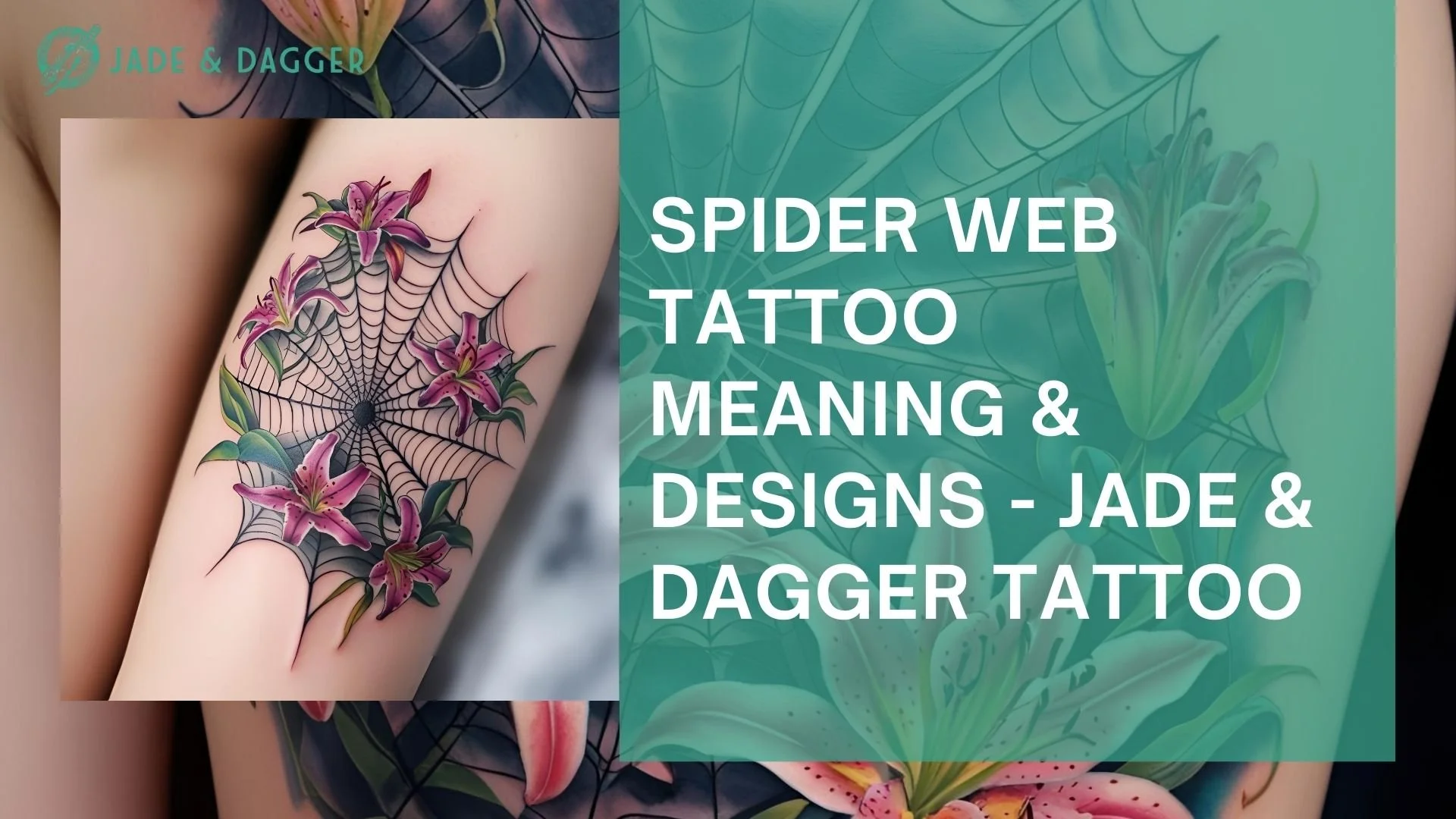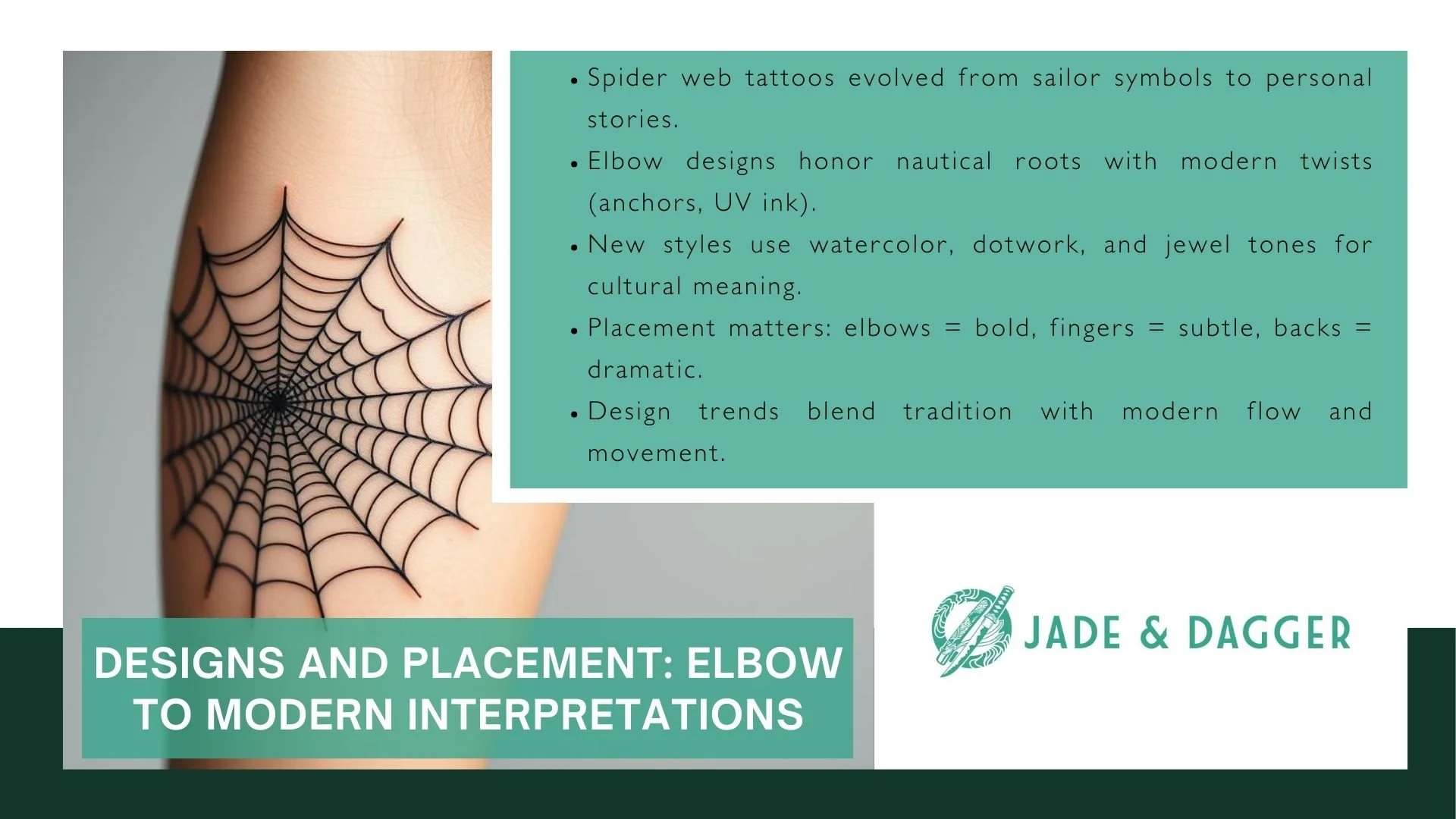Spider Web Tattoo Meaning & Designs - Jade & Dagger Tattoo
What starts as a simple pattern often becomes a story etched in ink. Once tied to rebellion, the spider’s web has spun its way into modern artistry as a symbol of resilience and reinvention. This guide unpacks its layered history, from gritty prison walls to sacred Indigenous traditions, revealing how a single design can hold opposing truths.
At Jade & Dagger Tattoo (403-244-6766), Calgary’s hub for boundary-pushing body art, these intricate webs aren’t just ink—they’re conversation starters. Artists here blend technical precision with fresh perspectives, transforming what some see as dark symbolism into personalized statements of growth.
You’ll discover how placement—like the elbow or neck—shapes a tattoo’s narrative. We’ll also explore safe practices for lasting vibrancy, because even the boldest designs deserve expert care. Ready to rethink assumptions? Let’s dive into the threads connecting history, culture, and self-expression.
Key Takeaways
Evolved from prison markers to symbols of creativity and personal strength
Dual roots in counterculture rebellion and Indigenous spiritual traditions
Placement (elbow, neck, etc.) influences visual impact and meaning
Modern interpretations focus on resilience and life’s interconnectedness
Professional studios like Jade & Dagger ensure safety and artistic quality
Understanding the Spider Web Tattoo Meaning
Behind the intricate lines lies a cultural evolution spanning decades. Originally popularized in 1970s correctional facilities, these patterns signaled time served—each concentric circle representing years behind bars. Yet Indigenous communities had already woven similar motifs into sacred art for centuries, honoring life’s delicate balance.
From Stigma to Storytelling
Early adopters saw the design’s geometry as fate’s blueprint. Sailors later adopted elbow webs to symbolize nautical miles traveled, blending maritime grit with personal milestones. “Clients now request these pieces to mark overcoming addiction or surviving loss,” shares a Calgary-based artist. The repeating spirals, once tied to confinement, now mirror life’s unpredictable twists.
Reinventing Tradition
Modern studios like Jade & Dagger Tattoo flip old narratives through color gradients and abstract elements. One client’s shoulder piece integrated wildfire imagery—a nod to Alberta’s landscapes and personal rebirth. This shift reflects broader cultural changes: 68% of millennials view body art as empowerment rather than rebellion, according to 2023 Canadian lifestyle surveys.
Today’s interpretations celebrate connection over confinement. Whether honoring ancestral roots or charting new beginnings, each design becomes a collaborative creation between wearer and artist. Ready to spin your own story?
The Native American Perspective on Spider Web Tattoos
Across countless generations, Indigenous artists have transformed nature’s patterns into sacred geometry. For many tribal communities, these designs aren’t mere decoration—they’re living maps of wisdom passed through oral histories and ceremonial practices.
Spider-Woman and Protective Myths
Navajo legends speak of Na'ashjé'ii Asdzáá, the Spider-Woman who weaves cosmic order from chaos. Newborns traditionally received invisible silk threads around their wrists—a spiritual safeguard against harm. “She connects us to life’s great loom,” explains a Cherokee elder’s account. Modern ink interpretations often incorporate turquoise accents or arrowhead motifs, grounding ancient beliefs in contemporary artistry.
Symbolism in Native American Culture
Three core principles shape these designs:
Interconnectedness: Radial patterns mirror kinship networks
Resilience: Delicate threads withstand storms
Creation: Empty spaces invite new possibilities
While prison culture framed webs as traps, Indigenous views celebrate their life-giving qualities. Calgary artists at studios like Jade & Dagger blend these concepts with urban styles—think geometric precision meeting watercolor splashes. One recent piece fused Haida formline shapes with bio-mechanical elements, proving traditions evolve without losing their roots.
How might your story weave into this legacy?
Spider Web Tattoo Meaning in Incarceration and Beyond
Skin becomes a canvas for coded messages in closed communities. Correctional facilities of the 1970s saw concentric circles inked on elbows—each ring marking a year served. This practice birthed associations with criminal activity that still linger today.
Prison Culture and Negative Connotations
Early adopters used these designs as unspoken résumés. A 1982 study found 73% of incarcerated individuals with elbow patterns confirmed their link to sentencing duration. But symbolism darkened as white supremacy groups co-opted the motif, adding numbers or initials to denote allegiance.
Three factors fueled negative connotations:
1970s-80s:
Association: Time served
Design Shift: Basic concentric rings
1990s-2000s:
Association: Gang affiliation
Design Shift: Added numerals/symbols
2010s-present:
Association: Personal transformation
Design Shift: Abstract integrations
Calgary tattoo artists report clients often request cover-ups of older pieces tied to troubled pasts. "We replace jagged lines with floral elements," notes a local ink specialist. This evolution mirrors broader societal shifts—64% of Canadians now view body art as therapeutic self-expression (2024 StatCan data).
While some still associate prison-made designs with danger, others reframe them as maps of resilience. The same pattern that once signaled confinement now often represents breaking free from it.
Designs and Placement: Elbow to Modern Interpretations
Body art transforms with every curve of the body. What began as sailors’ secret code now thrives as customizable storytelling. Artists today map intricate patterns across shoulders, ribs, and even fingers—each location adding new depth to age-old symbols.
Elbow Tattoos and Maritime Traditions
Nautical roots run deep in elbow ink. 19th-century seafarers marked voyages through concentric circles—one ring per 5,000 nautical miles. “These pieces became badges of survival,” notes a maritime historian’s journal. Modern wearers often blend this legacy with fresh elements:
Anchor motifs merged with compass roses
Wave-inspired shading techniques
UV-reactive ink for hidden details
Innovative Web Tattoos for Personal Expression
Contemporary studios reimagine radial patterns through unexpected mediums. Watercolor splashes dissolve strict geometry, while dotwork creates lace-like delicacy. A recent Calgary client chose collarbone placement with jewel-toned threads—symbolizing connections to their Métis heritage.
Black ink only:
Modern: Metallic accents
Impact: Adds dimensionality
Elbow-focused:
Modern: Full sleeve integrations
Impact: Enhances flow
Solid lines:
Modern: Negative space use
Impact: Creates movement
Placement shapes perception. Delicate finger webs whisper secrets, while back pieces command attention. Artists suggest considering skin texture and movement—elbow creases demand bold lines, whereas wrist designs thrive on subtlety. Every choice becomes part of the wearer’s visual language.
How to Safely Get a Spider Web Tattoo
Great body art begins with smart preparation. Calgary’s top studios blend safety protocols with creative collaboration, turning the process into an empowering experience rather than a transaction.
Choosing a Skilled Artist at Jade & Dagger Tattoo
Start by reviewing portfolios for radial pattern expertise. Jade & Dagger artists (403-244-6766) specialize in geometric precision, offering free consultations to discuss:
Autoclave sterilization certifications
Custom design adjustments for skin texture
Transparent pricing tiers
“We sketch three variations minimum,” explains lead artist Mara Kolev. “Elbow pieces need thicker lines—rib designs require softer shading.” Book early; their waitlist averages six weeks for intricate projects.
Aftercare and Maintenance Best Practices
Healing determines longevity. Follow this 14-day ritual:
Wash gently with fragrance-free soap
Apply thin layers of medical-grade ointment
Avoid pools, saunas, and direct sunlight
Canadian winters demand extra care—30% of color fading occurs during dry months. Use SPF 50+ year-round on exposed pieces. Touch-ups? Schedule them within 90 days for optimal pigment retention.
Embracing Personal Growth Through Spider Web Tattoo Meaning
Every line etched in skin can chart a course from struggle to strength. What began as a mark of confinement now thrives as dynamic body art documenting human tenacity. Modern wearers reimagine radial patterns as living timelines—each intersection celebrating victories over life’s toughest storms.
Resilience and Moving Beyond Adversity
Calgary artists report clients often request designs where broken threads morph into blooming flowers. “One survivor’s sleeve integrates 13 repaired tears—one for each year sober,” shares a Jade & Dagger specialist. These pieces transform historical stigma into wearable empowerment, with three common themes:
Geometric precision softening into organic shapes
Monochromatic bases accented with vibrant splashes
Hidden symbols (dates, coordinates) within the weave
The pattern’s evolution mirrors Canada’s shifting cultural landscape. 2023 surveys show 82% of ink enthusiasts prioritize personal significance over aesthetics alone. A recent Métis client’s collarbone piece blends traditional beadwork motifs with abstract webbing—honoring heritage while claiming new narratives.
Radial body art now functions as interactive journals. Wearers add elements during pivotal moments: a star after career milestones, raindrops during healing periods. This approach turns skin into a collaborative canvas where every strand whispers “I persisted.”
Your story deserves more than ink—it demands a design that grows as you do. Ready to spin shadows into strength?
Conclusion
Radial ink patterns have rewritten their own legacy—transforming from markers of confinement to emblems of creative freedom. This design’s journey mirrors life’s complexities: once signaling prison sentences, now celebrating Indigenous wisdom about interconnectedness. Calgary’s tattoo enthusiasts blend these histories into fresh narratives, proving symbols evolve when handled with care.
Jade & Dagger Tattoo (403-244-6766) leads this reinvention. Their artists merge technical skill with cultural sensitivity, creating pieces where geometric precision meets personal milestones. Whether honoring ancestral stories or marking hard-won growth, each collaboration becomes a testament to resilience.
Ready to reclaim narratives? Modern body art thrives on reinterpretation—elbow webs morph into floral mandalas, neck designs incorporate hidden coordinates. Every choice reflects your journey’s unique texture. After all, great ink isn’t just applied; it’s lived in.
Your skin holds space for endless possibilities. What begins as lines on paper becomes a living chronicle, blending history with tomorrow’s potential. Time to spin your truth into something that lasts.







